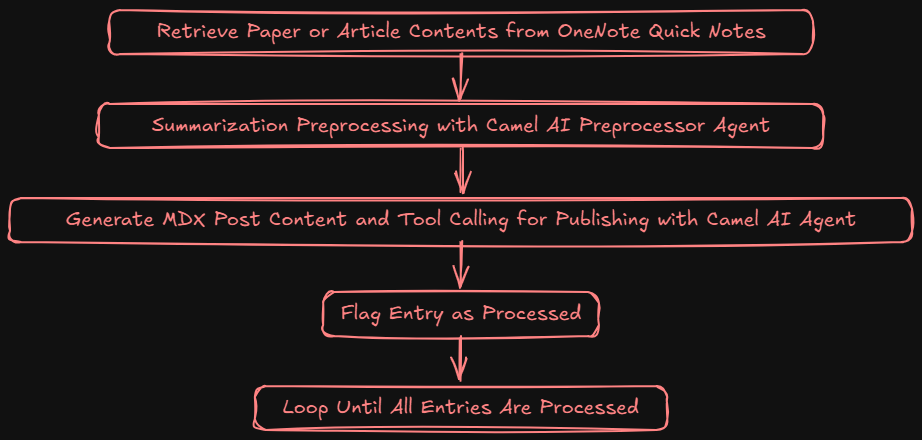Achieving Fully Automated Blog Creation with Camel Agents and Mistral AI
A practical exploration of how Camel AI agents utilize tools with Mistral AI to generate and publish blog posts from research papers retrieved from OneNote and committed to a GitHub repository.
9 min read

Introduction
Have you ever wished you could automate the entire process of creating and publishing blog posts? In this post, I explore the practical application of Camel AI agents using tools within the Mistral AI framework to automate the generation and publication of blog posts. Specifically, I describe a setup where the agent retrieves articles from Microsoft OneNote, processes them with Mistral AI, and then commits the generated content in MDX format to a GitHub repository for the blog.
This integration demonstrates the power of combining multiple tools to achieve seamless workflows. By automating the process of content generation and publication, Camel AI agents can save time and enhance productivity for bloggers, researchers, and content creators alike.
Setup Overview
The setup integrates several components that work together to generate and publish blog entries based on research papers or articles. Now that we understand the key components of the setup, let's see how they come together in a real-world workflow. The key components are:
-
Microsoft OneNote Integration: I clip articles or research papers into the 'Quick Notes' section of my Microsoft OneNote, which then serves as a convenient repository for the Camel AI agent to access and retrieve documents for content generation.
-
Mistral AI Language Models: The retrieved documents are then processed by Mistral AI models, specifically utilizing the Mistral Large model. The preprocessor agent uses Mistral's capabilities to summarize the key points, extract useful insights, and prepare the content for publishing.
-
MDX Blog Post Publishing Tool: A custom tool provided to the Camel AI agent enables it to publish the generated content. The agent generates the MDX content as an input argument for the tool, which then commits the content to the GitHub repository of the blog. This ensures that the content is published seamlessly, maintaining version control and providing a clear audit trail.
Camel Agent in Action: Retrieving and Publishing
Let's dive into how the Camel AI agents operate to retrieve and publish blog posts. To better illustrate the step-by-step functioning of this process, here's a detailed breakdown of the entire workflow. The process begins with the Camel AI preprocessor agent fetching articles from the "Quick Notes" section in OneNote. This integration allows users to easily store any research paper, article, or note they wish to turn into a blog post.
After retrieving the content, the Mistral AI Large model analyzes the document. Using a summarization approach, the model extracts the core ideas and formulates a draft that maintains the technical integrity of the original document while making it accessible to a broader audience. If the document is in a language other than English, the preprocessor agent translates it to English to ensure consistency.
Once the content is drafted, a separate Camel AI agent with tool-calling capabilities, also utilizing the Mistral Large model, generates the MDX post content following a specific format provided in the prompt, including references to the original source. This ensures that all MDX posts follow the same structure and include proper references to the original sources. The agent then calls the publishing tool, which commits the generated MDX file to the project's GitHub repository, automatically triggering a build and deploy process to publish the post.
Workflow of the Application
With a clear understanding of the workflow, let's explore how each tool contributes to making the automation seamless and the practical benefits they provide.
-
Retrieve Paper or Article Contents: The process starts by retrieving the contents of papers or articles from the personal Microsoft OneNote "Quick Notes" section.
-
Summarization Preprocessing: A Camel AI preprocessor agent summarizes the paper or article, effectively preprocessing the information to make it more concise and suitable for a blog post. If the content is in a different language, the agent also translates it to English during this step.
-
MDX Post Generation and Tool Calling for Publishing: The summarized content is then used by a separate Camel AI agent, which generates the MDX post content. The agent calls a tool to publish the post, taking the MDX post filename and post contents as arguments and committing it to the GitHub repository.
-
Flag Entry as Processed: After successfully generating and committing the MDX post, the corresponding Quick Note entry is flagged as processed to avoid redundant processing.
-
Loop Until All Entries Are Processed: This loop is repeated for all entries in the Quick Notes section that have not yet been processed.
This diagram illustrates the workflow and provides a visual representation of the entire process.

Diagram generated using Excalidraw integration with Mermaid.
Tool Usage and Practical Benefits
OneNote Retrieval: From Quick Notes to Blog Post
The integration with OneNote allows users to effortlessly collect articles and research papers that serve as the basis for blog posts. By keeping these documents organized in OneNote, the agent has a centralized location to pull content from, streamlining the retrieval process.
Generating Readable Blog Content with Camel AI Agents
The Camel AI agents work together to generate a reader-friendly MDX post. The preprocessor agent extracts and summarizes the content, while the tool-calling agent formats it into MDX, structuring the post with headings, paragraphs, and references to the original paper or article. This ensures a consistent style across all posts.
GitHub Integration: Automating Publication
Once the MDX file is ready, the agent commits it to the blog's GitHub repository. This integration ensures that the new content is automatically deployed, simplifying the publication process. Version control provided by GitHub also helps track changes and maintain a history of all published posts.
Conclusions
The seamless integration between OneNote, Mistral AI, and GitHub showcases the potential of using agents to automate content creation and dissemination, making the entire process quicker and more streamlined.
In future posts, I will cover agent definitions with code snippets, as well as experiences learned and issues encountered with tool calling using Camel AI with Mistral models. I will also discuss the integration with MS OneNote and GitHub. Stay tuned for these upcoming posts, where we'll dive deeper into the technical details and share valuable insights!
Useful Links
Enjoyed this post? Found it helpful? Feel free to leave a comment below to share your thoughts or ask questions. A GitHub account is required to join the discussion.
